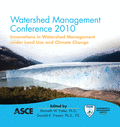Engineered Groundwater Recharge As Mitigation for Reduced Summer Low-Flow in the Upper Mattole River Watershed
Publication: Watershed Management 2010: Innovations in Watershed Management under Land Use and Climate Change
Abstract
By many accounts, the upper Mattole River has experienced significantly lower summer low-flow over the last 10 years (Klein 2004). This has created a condition where upper reaches of the river that formerly provided valuable cold-water rearing habitat for juvenile salmonids have been significantly impaired by the lack of flow (Downie, et al., 2002). Because the upper portions of the river channel are dominated by bedrock, it is unlikely that channel aggradation or increased subsurface flow has contributed to the observed low-flow condition in the upper basin. Nor does annual precipitation appear to have decreased significantly during this period (Klein 2004). Thus forcing two questions. Where has the water gone, given that total annual precipitation amounts have not changed significantly? And, what, if anything can be done to increase late dry-season base flow? Land use changes that have occurred over the past century have probably exacerbated low-flow conditions, including increased diversion of surface water, increased evaporation from manmade ponds, compaction of soils from logging and ranching activities, construction of impervious surfaces, draining of wetlands, and construction of roads. However, the majority of these changes occurred several decades ago, and thus, are probably not primarily responsible for the significant reductions in low-flow observed since 2000. Widespread timber harvest resulted in a vast network of logging roads, significant erosion, and compaction of surface soils, but most of this activity occurred from the 1950s until the 1970s. Although there has been some additional residential development in the watershed, there are no diversions in upper portions of the watershed and reductions in flow are observed even there. This leaves increased evapotranspiration by the forest and a changed climate regime as probable causes for the recent decreases in flow. Both altered forest stand composition and climate change have some degree of anthropogenic causation and, as with many other river systems, it seems likely that cumulative anthropogenic changes to the watershed are the primary cause for impaired water quality and degraded aquatic habitat. This project was undertaken to help determine if hydraulic modifications in the upper watershed could potentially increase the late summer base flow to help mitigate the observed drying up of this watershed.
Get full access to this article
View all available purchase options and get full access to this chapter.
Information & Authors
Information
Published In
Copyright
© 2010 American Society of Civil Engineers.
History
Published online: Apr 26, 2012
ASCE Technical Topics:
- Base flow
- Buildings
- Business management
- Compacted soils
- Flow (fluid dynamics)
- Fluid dynamics
- Fluid mechanics
- Geomechanics
- Geotechnical engineering
- Groundwater
- Groundwater recharge
- High-rise buildings
- Hydrologic engineering
- Low flow
- Mitigation and remediation
- Practice and Profession
- River engineering
- River systems
- Rivers and streams
- Soil mechanics
- Soils (by type)
- Structural engineering
- Structures (by type)
- Water (by type)
- Water and water resources
- Water management
- Watersheds
Authors
Metrics & Citations
Metrics
Citations
Download citation
If you have the appropriate software installed, you can download article citation data to the citation manager of your choice. Simply select your manager software from the list below and click Download.
